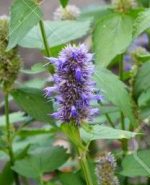
Also known as lavender hyssop and anise hyssop, this clump-forming herbaceous perennial is a member of the mint family, Lamiaceae, that also includes basil, sage, and ajuga. It is native to the northern Midwest and Great Plains where it grows in fields, dry upland forests, and prairies. Plants grow 2-4′ tall and have square stems bearing 2″ wide lanceolate leaves that are up to 4″ long and aromatic, and have coarsely toothed margins and grayish undersides covered with fine hairs. From mid to ate summer light blue to violet flowers are produced in densely packed terminal spikes 3-6″ long. The flowers do not bloom all at once and may have gaps between them. Each tubular flower is about 1/3″ long and has two lips, the lower one longer than the upper, and 4 long stamens Although the flowers are not fragrant they are attractive to bees, butterflies and hummingbirds. The genus name, Agastache, comes from the Greek words agan meaning very much and sachys meaning an ear of wheat and refers to the many flower spikes on the plant. The specific epithet, foeniculum, is the Latin diminutive of fenum or faenum, meaning hay.
Type: Herbaceous perennial
Bloom: Dense terminal spikes of two-lipped, tubular, light blue to violet flowers from mid to late summer
Size: 2-4′ H x 1.5-3′ W
Light:Full sun to part shade
Soil: Lean, medium moist to dry, well-drained
Hardiness: Zones 4-8
Care: Deadhead to prolong bloom
Pests and Diseases: R0ot rot, leafspot, rust, powdery mildew
Propagation: Seed, division
Companion Plants: Coneflower, blanket flower, daylily